The Cruel Sea:
German Airships, Part Three
by Mike Bennighof, Ph.D.
February 2024
 Our Second Great War alternative-history setting posits a world with a somewhat different technology than our own. I didn’t want the games set within it to play the same way as our historical Second World War at Sea games, just with different-colored pieces. And above all, I wanted it to include airships. Our Second Great War alternative-history setting posits a world with a somewhat different technology than our own. I didn’t want the games set within it to play the same way as our historical Second World War at Sea games, just with different-colored pieces. And above all, I wanted it to include airships.
The Cruel Sea, our massive expansion set for Second World War at Sea games Bismarck and Arctic Convoy, delivers the airships. The German Naval Airship Division has a full dozen of them, the most modern airships available. All use helium as their lifting gas, and all are capable of operating small contingents of fixed-wing aircraft.
Helium use limits the maximum altitude the airships can reach. The cells can only accommodate limited expansion without bursting as the airship flies higher; while the airship could vent gas to compensate the precious helium gas can’t be easily replaced like hydrogen. Germany has a secure supply from its East Africa colony, but the transport route is long and vulnerable to enemy attack. Helium therefore is to be preserved unless its venting is absolutely necessary.
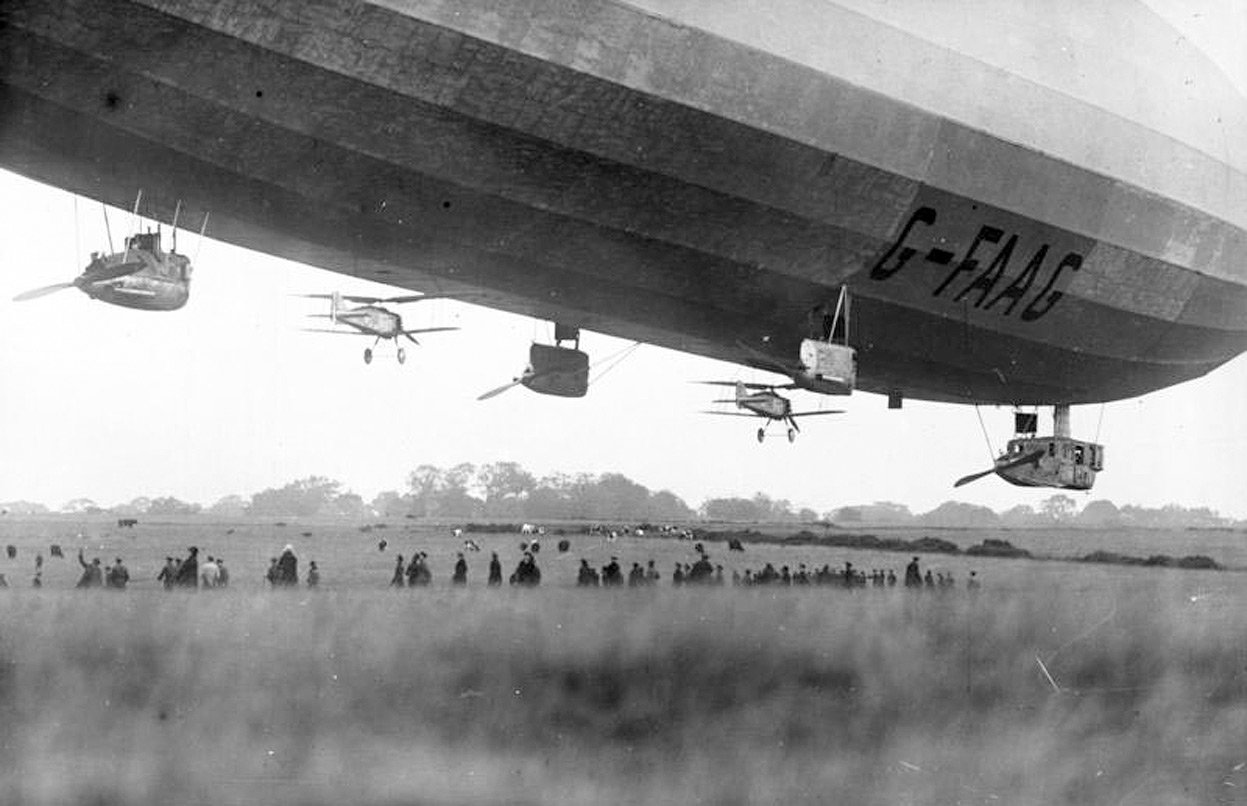
British airship R33 experiments with attached aircraft.
In The Cruel Sea, the Germans field two classes of flying carrier. There are seven examples of the Peter Strasser class, the lead ship christened when her namesake lay near death following the crash of the zeppelin L70 during airplane-recovery experiments, only to miraculously recover. Peter Strasser, the airship, is a huge ship of 9.5 million cubic feet capacity (the Hindenburg of our own world, in comparison, held 7 million cubic feet). Though designed by Karl Lanz, she and her sisters were built by the Zeppelin Works in their Friedrichshafen facility.
 She can carry 55,000 pounds’ worth of aircraft, which translates to a half-dozen loaded dive bombers or eight fighter planes. Like the well-known American Akron and Macon, she recovers her planes with a “trapeze” device to which airplanes attach themselves before being pulled into the hangar. Her supply of ordnance is limited, but the main role of her dive bombers is to extend the ship’s scouting range. Defenses include eight 20mm automatic cannon, in two dual mounts atop the envelope and two dual mounts below. They also carry a pair of machine guns at the rear of the aft gondola. The guns are a final point defense; the airship’s real protection against enemy fixed-aircraft is her organic fighter-plane element. She can carry 55,000 pounds’ worth of aircraft, which translates to a half-dozen loaded dive bombers or eight fighter planes. Like the well-known American Akron and Macon, she recovers her planes with a “trapeze” device to which airplanes attach themselves before being pulled into the hangar. Her supply of ordnance is limited, but the main role of her dive bombers is to extend the ship’s scouting range. Defenses include eight 20mm automatic cannon, in two dual mounts atop the envelope and two dual mounts below. They also carry a pair of machine guns at the rear of the aft gondola. The guns are a final point defense; the airship’s real protection against enemy fixed-aircraft is her organic fighter-plane element.
Seven of the big ships are present in The Cruel Sea, out of a total class of twelve.

The American flying carrier Akron recovers a fighter plane.
The huge “Valkyrie” class (all named for Valkyries of Germanic myth) is even larger, with a capacity of 12 million cubic feet of lifting gas. They’re over 380 meters long (by way of comparison, the Hindenburg of our own history – the largest airship ever built - was 245 meters long). That gives them the ability to carry 90,000 pounds of aircraft, plus their fuel, ordnance and other stores.
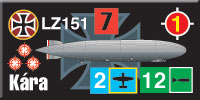 That allows a Valkyrie to carry two of the half-squadrons into which the Naval Airship Service’s fixed-wing squadrons are organized. Typically they carry one of fighters and one of dive bombers, but Strasser envisions true deep strike missions for the Valkyries in which several of them take dozens of dive bombers to attack targets thousands of miles from Germany, targets that have few if any air defenses. The vast range of the huge airships, combined with bases in German colonies or allied nations like Brazil or Ottoman Turkey, theoretically puts the entire globe within reach of German air power. That allows a Valkyrie to carry two of the half-squadrons into which the Naval Airship Service’s fixed-wing squadrons are organized. Typically they carry one of fighters and one of dive bombers, but Strasser envisions true deep strike missions for the Valkyries in which several of them take dozens of dive bombers to attack targets thousands of miles from Germany, targets that have few if any air defenses. The vast range of the huge airships, combined with bases in German colonies or allied nations like Brazil or Ottoman Turkey, theoretically puts the entire globe within reach of German air power.
For point defense, the Valkyries have sixteen 20mm cannon in eight twin mounts, four of them on their upper side and four more below. Though seemingly a great deal of firepower, the gun mounts are spread over a great deal of space. There are also four machine guns mounted on the gondolas. An airship’s guns can do little other than harass attacking fixed-wing aircraft; as with the Peter Strasser class, it’s the airship’s own fighter planes that provide the real defense.
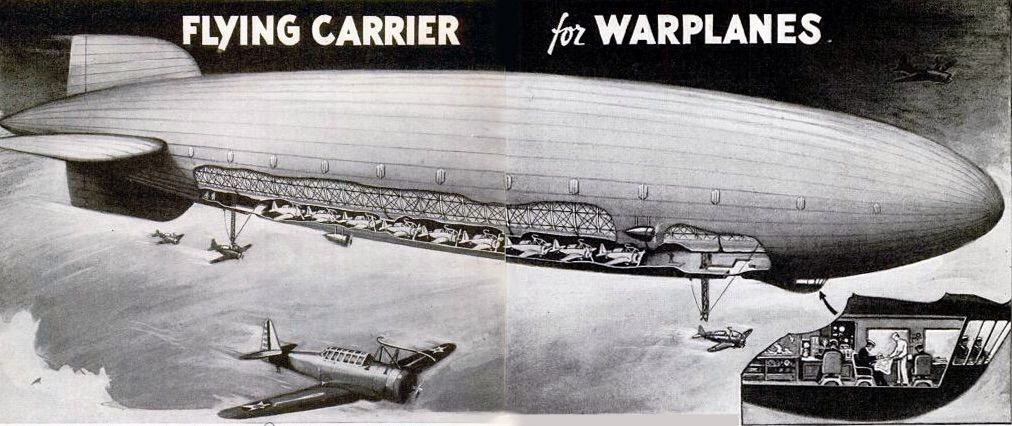
A rather fanciful view of the flying carrier concept.
The German Naval Airship Division operates five Valkyrie-class ships, with another seven either authorized or under construction when war breaks out in August 1940. A further two ships were sold to Brazil, though they operate with a German crew cadre. The Brazilians use their ships as aerial command centers, something made much more difficult within the German Navy thanks to the rivalry between Strasser and the sea-going admirals.
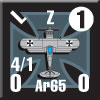 The flying carriers, whether German or Brazilian, operate a pair of biplanes, the Arado Ar.65 fighter and the Heinkel He.50 dive bomber. These are modified versions of the land-based models, with their landing gear removed and recovery gear fitted to the center of the top wing. The flying carriers, whether German or Brazilian, operate a pair of biplanes, the Arado Ar.65 fighter and the Heinkel He.50 dive bomber. These are modified versions of the land-based models, with their landing gear removed and recovery gear fitted to the center of the top wing.
The Ar.65 was a biplane single-seat fighter, armed with a pair of machine guns. It had a liquid-cooled BMW engine that produced good power and speed for its day, and it was considered a maneuverable plane. In our own reality, Arado built 85 of them, initially under a contract from the Weimar Republic continued under the Nazis. The plane entered service in 1931 as the second fighter built after Germany abandoned the Versailles Treaty limitations on aircraft. By 1935 it had been relegated to training status.
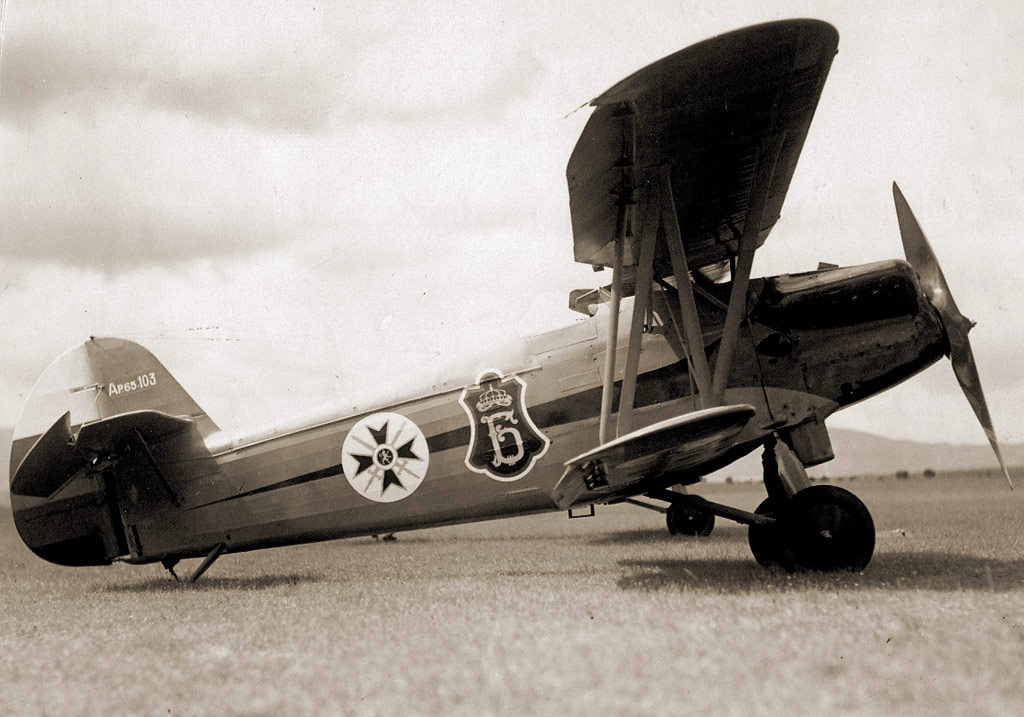
An Arado 65 fighter in Royal Bulgarian Air Force livery.
The He.50, also a biplane, was a dive-bomber, the original “Stuka.” It also first appeared in 1931, as a prototype for a Japanese Navy carrier-based dive-bomber. The Japanese took delivery of just one plane, the third prototype built, then reverse-engineered the sample to produce the Aichi D1A dive bomber.
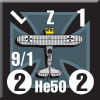 The Republic of China ordered a dozen examples of the second prototype, with an improved engine, but the newly-established German Air Force took them over before delivery (which was possibly the intent all along). These equipped the first Luftwaffe dive-bomber squadron, and 60 more were ordered. By the end of the 1930’s all had been relegated to training as the Ju87 replaced them in front-line squadrons, but they saw some action in World War II as ground-attack and night harassment aircraft. The Republic of China ordered a dozen examples of the second prototype, with an improved engine, but the newly-established German Air Force took them over before delivery (which was possibly the intent all along). These equipped the first Luftwaffe dive-bomber squadron, and 60 more were ordered. By the end of the 1930’s all had been relegated to training as the Ju87 replaced them in front-line squadrons, but they saw some action in World War II as ground-attack and night harassment aircraft.
In the world of the Second Great War, fixed-wing aircraft development is much less advanced than that of our own history. These planes developed in 1931 and serving in the early 1930’s represent first-line technology in our alternative-history 1940. While in keeping with our story line, that also allows us to present playing pieces for older airplanes that really existed, but would never otherwise have their day in Second World War at Sea format.
You can order The Cruel Sea right here, right now.
Sign up for our newsletter right here. Your info will never be sold or transferred; we'll just use it to update you on new games and new offers.
Mike Bennighof is president of Avalanche Press and holds a doctorate in history from Emory University. A Fulbright Scholar and NASA Journalist in Space finalist, he has published a great many books, games and articles on historical subjects; people are saying that some of them are actually good.
He lives in Birmingham, Alabama with his wife and three children. He will never forget his Iron Dog, Leopold. Leopold feared ocean waves.
Want to keep Daily Content free of third-party ads? You can send us some love (and cash) through this link right here.
|
